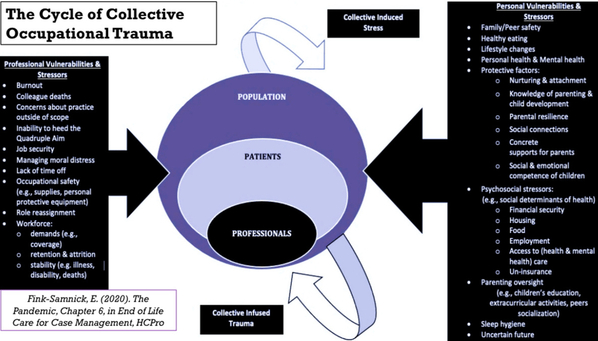 The pandemic has hit its one year milestone. The mental health of the health and behavioral health workforce is among the loudest adverse effects of these times. Life and the healthcare industry are fraught with stress; these dynamics are not new. But the horrific events of this year have eclipsed in a new dimension of trauma for every discipline to contend with.
The pandemic has hit its one year milestone. The mental health of the health and behavioral health workforce is among the loudest adverse effects of these times. Life and the healthcare industry are fraught with stress; these dynamics are not new. But the horrific events of this year have eclipsed in a new dimension of trauma for every discipline to contend with.
New Dimensions of Trauma
Collective occupational trauma (Fink-Samnick, 2020) is front and center. In this space, practitioners, professionals, and providers experience the same reality as their patients. Few have escaped worry about the virus, fear of transmission, and concerns for mortality. Boundaries between professionals, their patients, and the population become easily blurred. A fierce dynamic is put into motion: intense levels of collective induced stress are endured by the population and passed on to involved professionals in the form of collective infused trauma. In turn, the workforce has no space to escape the wide range of professional and personal stressors they equally face. This cycle becomes all encompassing. The result: disruptions impact sleep (e.g., nightmares, insomnia), diet (e.g., gastrointestinal upset), prompt physical symptoms (e.g., headaches, back or joint pain, psychophysiologic disorders), impede focus, and ultimately our ability, motivation, or desire to function, whether at work or in life.
We are Beyond, Process and Roll
The stress of these occupational experiences cannot be minimized or ignored. Increasing workforce suicides have taken a grim toll on our ranks and will continue to without dedicated attention. Healthcare professionals often cope by engaging in, what I refer to as, process and roll; quickly moving from one patient or task to the next. There is no stigma in acknowledging feeling a bit off, angry, sad, or distant from patient experiences. Yet, doing nothing about those common perspectives is unacceptable and will lead to a traumatic response.
Tackle Collective Occupational Trauma and Restore Your Resilience
Here are 10 ways to tackle Collective Occupational Trauma and restore your resilience
- Keep as normal a routine as possible: get a good night sleep, eat nutritious and regular meals, and exercise. Take a brief brisk walk or virtual exercise class to clear your head and keep endorphins moving.
- Schedule virtual get togethers to socialize: happy hours, meals, movies, dance parties) or weekly chats with friends and family. As vaccine rates increase, expand to safe distancing outings.
- Get outside: With more people working remotely, it becomes easy to stay inside. Make sure to get out several times a week!
- Discuss non-pandemic related happenings at work: It’s an occupational hazard to talk about work, but STOP! Force yourself to have conversations about other topics: share pictures of other life events new family members (human or pets), discuss new recipes.
- Engage in Sleep Hygiene: The Sleep Foundation website has solid guidance on ways to get a good night’s sleep.
- Relax and Renew: Use mobile device applications for relaxation and restoration
- Access employee assistance programs through your employer. These programs link the workforce with short, and then longer term counseling as necessary.
- Seek Behavioral Health Support: There is no stigma seeking mental health intervention. Mental health providers are accessible through insurance provider listings, Psychology Today.
- Access Emotional PPE: The industry itself has also stepped up with a massive behavioral health resources for the workforce in the form specialized workbooks, therapy, and hotlines.
- The Emotional PPE Project connects healthcare workers in need with licensed mental health professionals. It also provides a clearinghouse for mental health practitioners who provide pro-bono services. The Center to Advance Palliative Care (CAPC) COVID-19 Response Resource Hub also provides sound resources.
- Psych Hub provide mental health education for those wanting more knowledge on how to intervene
- Well-being Trust focus on workforce and population-based resilience
- The COVID Anxiety Workbook is free resource for the public to guide management of intense emotions.
- Stay Informed on Collective Occupational Trauma Signs and Symptoms: Stay aware of signs and symptoms of these appropriate responses, and take action as needed.
Stay mindful, aware, and support each other. We were human beings first, long before becoming health and behavioral health professionals. As a result, it is a mandate that we safeguard our human condition to address the human condition of others. Remember, our health and behavioral health workforce is far too valuable for far too many.
Further information about the Cycle of Collective Occupational Trauma can be found in End of Life Care for Case Management, available on the HCPro Marketplace.




Comments (1)